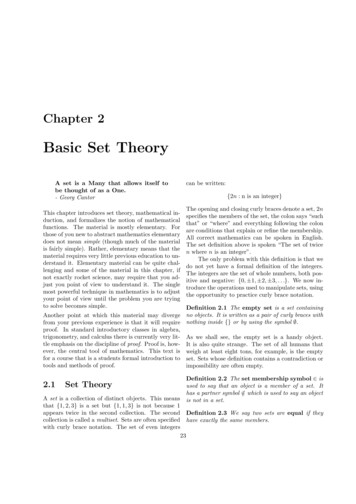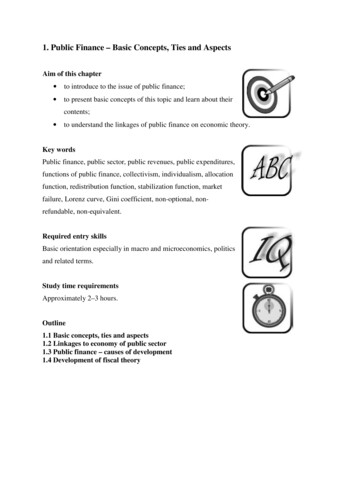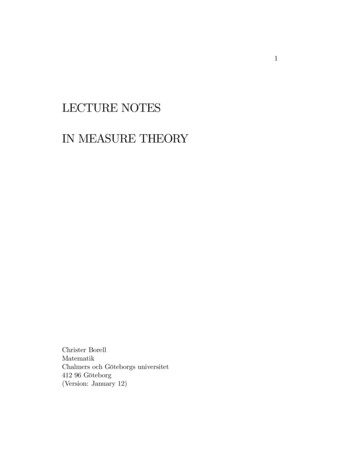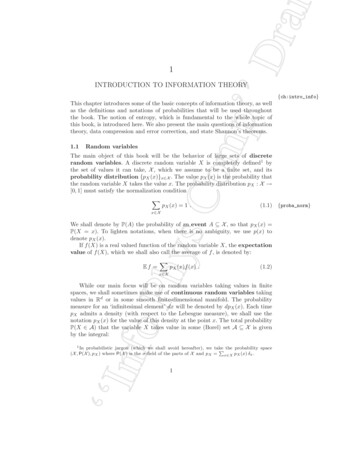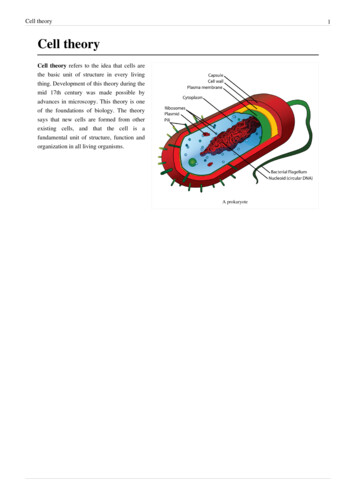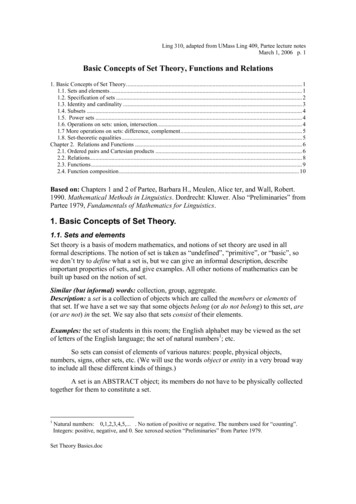
Transcription
Ling 310, adapted from UMass Ling 409, Partee lecture notesMarch 1, 2006 p. 1Basic Concepts of Set Theory, Functions and Relations1. Basic Concepts of Set Theory. 11.1. Sets and elements . 11.2. Specification of sets . 21.3. Identity and cardinality . 31.4. Subsets . 41.5. Power sets . 41.6. Operations on sets: union, intersection. 41.7 More operations on sets: difference, complement. 51.8. Set-theoretic equalities . 5Chapter 2. Relations and Functions . 62.1. Ordered pairs and Cartesian products . 62.2. Relations. 82.3. Functions. 92.4. Function composition. 10Based on: Chapters 1 and 2 of Partee, Barbara H., Meulen, Alice ter, and Wall, Robert.1990. Mathematical Methods in Linguistics. Dordrecht: Kluwer. Also “Preliminaries” fromPartee 1979, Fundamentals of Mathematics for Linguistics.1. Basic Concepts of Set Theory.1.1. Sets and elementsSet theory is a basis of modern mathematics, and notions of set theory are used in allformal descriptions. The notion of set is taken as “undefined”, “primitive”, or “basic”, sowe don’t try to define what a set is, but we can give an informal description, describeimportant properties of sets, and give examples. All other notions of mathematics can bebuilt up based on the notion of set.Similar (but informal) words: collection, group, aggregate.Description: a set is a collection of objects which are called the members or elements ofthat set. If we have a set we say that some objects belong (or do not belong) to this set, are(or are not) in the set. We say also that sets consist of their elements.Examples: the set of students in this room; the English alphabet may be viewed as the setof letters of the English language; the set of natural numbers1; etc.So sets can consist of elements of various natures: people, physical objects,numbers, signs, other sets, etc. (We will use the words object or entity in a very broad wayto include all these different kinds of things.)A set is an ABSTRACT object; its members do not have to be physically collectedtogether for them to constitute a set.1Natural numbers: 0,1,2,3,4,5,. . No notion of positive or negative. The numbers used for “counting”.Integers: positive, negative, and 0. See xeroxed section “Preliminaries” from Partee 1979.Set Theory Basics.doc
Ling 310, adapted from UMass Ling 409, Partee lecture notesMarch 1, 2006 p. 2The membership criteria for a set must in principle be well-defined, and not vague.If we have a set and an object, it is possible that we do not know whether this objectbelongs to the set or not, because of our lack of information or knowledge. (E.g. “The setof students in this room over the age of 21”: a well-defined set but we may not know whois in it.) But the answer should exist, at any rate in principle. It could be unknown, but itshould not be vague. If the answer is vague for some collection, we cannot consider thatcollection as a set. Another thing: If we have a set, then for any two elements of it, x and y,it should not be vague whether x y, or they are different. (If they are identical, then theyare not actually “two” elements of it; the issue really arises when we have two descriptionsof elements, and we want to know whether those descriptions describe the same element,or two different elements.)For example: is the letter q the same thing as the letter Q? Well, it depends on whatset we are considering. If we take the set of the 26 letters of the English alphabet, then qand Q are the same element. If we take the set of 52 upper-case and lower-case letters ofthe English alphabet, then q and Q are two distinct elements. Either is possible, but wehave to make it clear what set we are talking about, so that we know whether or not q Q.Sometimes we simply assume for the sake of examples that a description is notvague when perhaps for other purposes it would be vague – e.g., the set of all red objects.Sets can be finite or infinite.There is exactly one set, the empty set, or null set, which has no members at all.A set with only one member is called a singleton or a singleton set. (“Singleton of a”)Notation: A, B, C, for sets; a, b, c, or x, y, z, for members.b A if b belongs to A (B A if both A and B are sets and B is a member of A)and c A, if c doesn’t belong to A. is used for the empty set.1.2. Specification of setsThere are three main ways to specify a set:(1) by listing all its members (list notation);(2) by stating a property of its elements (predicate notation);(3) by defining a set of rules which generates (defines) its members (recursive rules).List notation. The first way is suitable only for finite sets. In this case we list names ofelements of a set, separate them by commas and enclose them in braces:Examples: {1, 12, 45}, {George Washington, Bill Clinton}, {a,b,d,m}.“Three-dot abbreviation”: {1,2, ., 100}. (See xeroxed “preliminaries”, pp xxii-xxiii){1,2,3,4, } – this is not a real list notation, it is not a finite list, but it’s common practiceas long as the continuation is clear.Note that we do not care about the order of elements of the list, and elements can be listedseveral times. {1, 12, 45}, {12, 1, 45,1} and {45,12, 45,1} are different representations ofthe same set (see below the notion of identity of sets).Set Theory Basics.doc
Ling 310, adapted from UMass Ling 409, Partee lecture notesMarch 1, 2006 p. 3Predicate notation. Example:{x x is a natural number and x 8}Reading: “the set of all x such that x is a natural number and is less than 8”So the second part of this notation is a property the members of the set share (a conditionor a predicate which holds for members of this set).Other examples:{ x x is a letter of Russian alphabet}{y y is a student of UMass and y is older than 25}General form:{ x P(x)}, where P is some predicate (condition, property).The language to describe these predicates is not usually fixed in a strict way. But it isknown that unrestricted language can result in paradoxes. Example: { x x x}. (“Russell’sparadox”) -- see the historical notes about it on pp 7-8. The moral: not everything thatlooks on the surface like a predicate can actually be considered to be a good definingcondition for a set. Solutions – type theory, other solutions; we won’t go into them. (Ifyou’re interested, see Chapter 8, Sec 2.)Recursive rules. (Always safe.) Example – the set E of even numbers greater than 3:a) 4 Eb) if x E, then x 2 Ec) nothing else belongs to E.The first rule is the basis of recursion, the second one generates new elements from theelements defined before and the third rule restricts the defined set to the elementsgenerated by rules a and b. (The third rule should always be there; sometimes in practice itis left implicit. It’s best when you’re a beginner to make it explicit.)1.3. Identity and cardinalityTwo sets are identical if and only if 2 they have exactly the same members. So A B iff forevery x, x A x B.For example, {0,2,4} {x x is an even natural number less than 5}From the definition of identity follows that there exists only one empty set; its identity isfully determined by its absence of members. Note that empty list notation {} is not usuallyused for the empty set, we have a special symbol for it.The number of elements in a set A is called the cardinality of A, written A . Thecardinality of a finite set is a natural number. Infinite sets also have cardinalities but theyare not natural numbers. We will discuss cardinalities of infinite sets a little later (Chapter4).2Be careful about “if and only if”; its abbreviation is iff. See Preliminaries, p. xxiii.Set Theory Basics.doc
Ling 310, adapted from UMass Ling 409, Partee lecture notesMarch 1, 2006 p. 41.4. SubsetsA set A is a subset of a set B iff every element of A is also an element of B. Such a relationbetween sets is denoted by A B. If A B and A B we call A a proper subset of B andwrite A B. (Caution: sometimes is used the way we are using .)Both signs can be negated using the slash / through the sign.Examples:{a,b} {d,a,b,e} and {a,b} {d,a,b,e}, {a,b} {a,b}, but {a,b} {a,b}.Note that the empty set is a subset of every set. A for every set A. Why?Be careful about the difference between “member of” and “subset of”!1.5. Power setsThe set of all subsets of a set A is called the power set of A and denoted as (A) orsometimes as 2A.For example, if A {a,b}, (A) { , {a}, {b}, {a,b}}.From the example above: a A; {a} A; {a} (A) A; A; (A); (A)1.6. Operations on sets: union, intersection.We define several operations on sets. Let A and B be arbitrary sets.The union of A and B, written A B, is the set whose elements are just the elements ofA or B or of both. In the predicate notation the definition isA B def { x x A or x B}Examples. Let K {a,b}, L {c,d} and M {b,d}, thenK L {a,b,c,d}K M {a,b,d}L M {b,c,d}(K L) M K (L M) {a,b,c,d}K K KK K K {a,b}.The intersection of A and B, written A B, is the set whose elements are just theelements of both A and B. In the predicate notation the definition isA B def { x x A and x B}Examples:K L K M {b}L M {d}(K L) M K (L M) K K KK K .Set Theory Basics.doc
Ling 310, adapted from UMass Ling 409, Partee lecture notesMarch 1, 2006 p. 51.7 More operations on sets: difference, complementAnother binary operation on arbitrary sets is the difference “A minus B”, written A – B,which ‘subtracts’ from A all elements which are in B. [Also called relative complement:the complement of B relative to A.] The predicate notation defines this operation asfollows:A – B def { x x A and x B}Examples: (using the previous K, L, M)K–L {a,b}K–M {a}L–M {c}K–K K– K –K .A – B is also called the relative complement of B relative to A. This operation is tobe distinguished from the complement of a set A, written A’, which is the set consisting ofeverything not in A. In predicate notationA’ def { x x A}It is natural to ask, where do these objects come from which do not belong to A? Inthis case it is presupposed that there exists a universe of discourse and all other sets aresubsets of this set. The universe of discourse is conventionally denoted by the symbol U.Then we haveA’ def U – A1.8. Set-theoretic equalitiesThere are a number of general laws about sets which follow from the definitions of settheoretic operations, subsets, etc. A useful selection of these is shown below. They aregrouped under their traditional names. These equations below hold for any sets X, Y, Z:1. Idempotent Laws(a) X X X2. Commutative Laws(a) X Y Y X(b) X X X(b) X Y Y X3. Associative Laws(a) (X Y) Z X (Y Z)(b) (X Y) Z X (Y Z)4. Distributive Laws(a) X (Y Z) (X Y) (X Z)Set Theory Basics.doc(b) X (Y Z) (X Y) (X Z)
Ling 310, adapted from UMass Ling 409, Partee lecture notesMarch 1, 2006 p. 65. Identity Laws(a) X X(b) X U U6. Complement Laws(a) X X’ U(b) (X’)’ X7. DeMorgan’s Laws(a) (X Y)’ X’ Y’8. Consistency Principle(a) X Y iff X Y Y(c) X (d) X U X(c) X X’ (d) X – Y X Y’(b) (X Y)’ X’ Y’(b) X Y iff X Y XChapter 2. Relations and FunctionsMuch of mathematics can be built up from set theory – this was a project which wascarried out by philosophers, logicians, and mathematicians largely in the first half of the20th century. Whitehead and Russell were among the pioneers, with their great workPrincipia Mathematica. Defining mathematical notions on the basis of set theory does notadd anything “mathematical”, and is not of particular interest to the “workingmathematician”, but it is of great interest for the foundations of mathematics, showing howlittle needs to be assumed as “primitive”.We illustrate some bits of that project here, with some basic set-theoretic definitions ofordered pairs, relations, and functions, along with some standard notions concerningrelations and functions.2.1. Ordered pairs and Cartesian productsAs we see, there is no order imposed on the elements of a set. To describe functionsand relations we will need the notion of an ordered pair, written a,b , for example, inwhich a is considered the first member (element) and b is the second member (element) ofthe pair. So, in general, a,b b,a . (Whereas for a set, {a,b} {b,a}.)Is there a way to define ordered pairs in terms of sets? You might think not, since setsare themselves unordered. But there are in fact various ways it can be done. Here is oneway to do it, usually considered the most conventional:The ordered pair can be defined as follows:Definition: a,b def {{a}, {a,b}}Set Theory Basics.doc
Ling 310, adapted from UMass Ling 409, Partee lecture notesMarch 1, 2006 p. 7How can we be sure that that definition does the job it’s supposed to do? What’s crucial is that forevery ordered pair, there is indeed exactly one corresponding set of the form {{a}, {a,b}}, and twodifferent ordered pairs always have two different corresponding sets. We won’t try to prove thatthat holds, but it does.There would be nothing wrong with taking the notion of ordered pair as anotherprimitive notion, alongside the notion of set. But mathematicians like seeing how far theycan reduce the number of primitives, and it’s an interesting discovery to see that the notionof order can be defined in terms of set theory.Cartesian product. Suppose we have two sets A and B and we form ordered pairs bytaking an element of A as the first member of the pair and an element of B as the secondmember. The Cartesian product of A and B, written A B, is the set consisting of all suchpairs. The predicate notation defines it as:A B def { x,y x A and y B}What happens if either A or B is ? Suppose A {a,b}. What is A ?Here are some examples of Cartesian products:Let K {a,b,c} and L {1,2}, thenK L { a,1 , a,2 , b,1 , b,2 , c,1 , c,2 }L K { 1,a , 2,a , 1,b , 2,b , 1,c , 2,c }L L { 1,1 , 1,2 , 2,1 , 2,2 }An aside on cardinality, and why Cartesian products are called products (the “Cartesian”part comes from the name of René Descartes, their inventor). Look at the cardinalities ofthe sets above, and see if you can figure out in general what the cardinality of the set A Bwill be, given the cardinalities of sets A and B.What about ordered triples? The definition of ordered pairs can be extended to orderedtriples and in general to ordered n-tuples for any natural n. For example, ordered triples areusually defined as: a,b,c def a,b ,c And for three sets A, B and C the Cartesian product can be defined asA B C def ((A B) C)In the case when A B C a special notation is used: A A A2, A A A A3,etc. And we put A1 def A. (This notation mimics the notation used for multiplication andexponents. It can, because the parallels hold quite uniformly.)Set Theory Basics.doc
Ling 310, adapted from UMass Ling 409, Partee lecture notesMarch 1, 2006 p. 82.2. RelationsIn natural language relations are a kind of links existing between objects. Examples:‘mother of’, ‘neighbor of’, “part of”, ‘is older than’, ‘is an ancestor of’, ‘is a subset of’, etc.These are binary relations. Formally we will define relations between elements of sets.We may write Rab or aRb for “a bears R to b”. And when we formalize relations assets of ordered pairs of elements, we will officially write a,b R.If A and B are any sets and R A B, we call R a binary relation from A to B or a binaryrelation between A and B. A relation R A A is called a relation in or on A.The set dom R {a a,b R for some b} is called the domain of the relation R and theset range R {b a,b R for some a} is called the range of the relation R.We may visually represent a relation R between two sets A and B by arrows in adiagram displaying the members of both sets. In Figure 2-1 in PtMW [Partee, ter Meulen,and Wall], A {a.b}, B {c,d,e}, and the arrows represent a set-theoretic relation R { a,d , a,e , b,c }.[see Fig 2-1, p. 29.]Let us consider some operations on relations. The complement of a relationR A B is defined asR’ def (A B) – R.Note that what the complement of a relation is depends on what universe we areconsidering. A given relation may certainly be a subset of more than one Cartesianproduct, and its complement will differ according to what Cartesian product we are takingto be the relevant universe.What is the complement of the relation R { a,d , a,e , b,c } on the universe {a,b} {c,d,e}? (Answer: R’ { a,c , b,d , b,e }.)The inverse of a relation R A B is defined as the relation R–1 B A,R–1 def { b,a a,b R}. Note that (R–1)-1 R.For example, for the relation R given above,R’ { a,c , b,d , b,e } and R–1 { d,a , e,a , c,b }.More examples: Let be the set of natural numbers, {0, 1, 2, 3, 4, . }Let R be “is less than” on (i.e., on )Then what is R’?What is R-1?We have focused so far on binary relations, i.e., sets of ordered pairs. In a similar waywe could define ternary, quaternary or just n-place relations consisting respectively ofordered triples, quadruples or n-tuples. A unary relation R on a set A is just a subset of theset A.Set Theory Basics.doc
Ling 310, adapted from UMass Ling 409, Partee lecture notesMarch 1, 2006 p. 92.3. FunctionsExamples of functions:f(x) x2 1f(x) the mother of xIntuitively a function may be thought of as a “process” or as a correspondence.A function is generally represented in set-theoretic terms as a special kind of relation.Definition: A relation F from A to B is a function from A to B if and only if it meets bothof the following conditions:1. Each element in the domain of F is paired with just one element in the range, i.e., from a,b F and a,c F follows that b c.2. The domain of F is equal to A, domF A.Equivalent definition: A function is a subset R of A B such that each element of Aoccurs as the first member of exactly one ordered pair in R.For example, consider the sets A {a.b} and B {1,2,3}. The following relations from Ato B are functions from A to B:P { a,1 , b,1 }Q { a,2 , b,3 }The following relations from A to B are not functions from A to B:S { a,1 }T { a,2 , b,1 , b,3 }S does not satisfy the condition 2, and T fails to meet condition 1. S is a function on thesmaller domain {a}; T is not a function at all.Much of the terminology used in talking about functions is the same as that forrelations. We say that a function with domain A and range a subset of B is a function fromA to B, while one in A A is said to be a function in or on A. The notation‘F: A B’ is used for ‘F is a function from A to B’. Elements of the domain of a functionare called arguments and their correspondents in the range, values. If a,b F, thefamiliar notation F(a) b is used. ‘Map’, ‘mapping’ are commonly used synonyms for‘function’. A function maps each argument onto a corresponding value. A function F: An A is also called an n-ary operation in A.Functions as processes. Sometimes functions are considered in a different way, asprocesses, something like devices or boxes with inputs and outputs. We put the argumentin the input and get the value of the function in output. In this case the set of ordered pairsin our definition is called the graph of the function.Sometimes partial functions are considered. In this case the condition 2 in ourdefinition can fail.Set Theory Basics.doc
Ling 310, adapted from UMass Ling 409, Partee lecture notesMarch 1, 2006 p. 10Some terminology. Functions from A to B in the general case are said to be into B. If therange of the function equals B, then the function is onto B (or surjection). A functionF: A B is called one-to-one function (or injection) just in case no member of B isassigned to more than one member of A (so if a b, then F(a) F(b)). A function which isboth one-to-one and onto is called a one-to-one correspondence (or bijection). It is easy tosee that if a function F is one-to-one correspondence, then the relation F–1 is a function andone-to-one correspondence.In Figure 2-2 three functions are indicated by the same sort of diagrams weintroduced previously for relations. It is easy to see that functions F and G are onto but His not.[See PtMW, p. 32, Fig.2-2]One useful class of functions are characteristic functions of sets. The characteristic function of aset S, considered as a subset of some larger domain D, is defined as follows:FS : D {0,1} : FS (x) 1 iff x SFS (x) 0 otherwiseThere is a one-to-one correspondence between sets and their characteristic functions. In semantics,where it is common to follow Frege in viewing much of semantic composition as carried out byfunction-argument application, it is often convenient to work with the characteristic functions ofsets rather than with sets directly. Characteristic functions are used in many other applications aswell.2.4. Function compositionGiven two functions F: A B and G: B C, we may form a new function from A to C,called the composition of F and G, written G F. Function composition is defined asG F def { x,z for some y, x,y F and y,z G }Figure 2-3 shows two functions F and G and their composition.[See PtMW, p. 33, Fig.2-3]The function F: A A such that F { x,x x A} is called the identity function on A,written idA (or 1A). Given a function F: A B that is a one-to-one correspondence, wehave the following equations:F–1 F idA,F F–1 what? [if we don’t get this far in class, the answer is in the book.]The definition of composition need not be restricted to functions but can be applied torelations in general. Given relations R A B and S B C the composite of R and S,written S R def { x,z for some y, x,y R and y,z S }Set Theory Basics.doc
Ling 310, adapted from UMass Ling 409, Partee lecture notes March 1, 2006 p. 4 Set Theory Basics.doc 1.4. Subsets A set A is a subset of a set B iff every element of A is also an element of B.Such a relation between sets is denoted by A B.If A B and A B we call A a proper subset of B and write A B. (Caution: sometimes is used the way we are using .)
